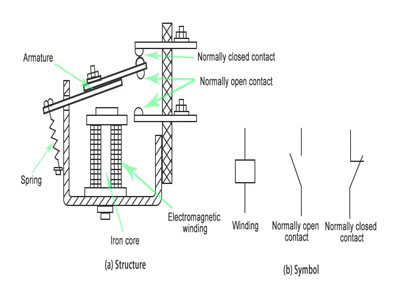Key Takeaway
The principle of a relay is based on electromagnetic attraction. When energized, a relay operates by using a signal, often provided by microcontrollers or microprocessors in modern applications. This electromagnetic action causes a set of contacts within the relay to open or close, thereby controlling a circuit. Relays are crucial in power systems for detecting faults and preventing damage by automatically interrupting power flows. This simple yet effective mechanism allows relays to handle various control and safety functions in electrical systems.
The Basic Concept of Relay Operation
A relay is essentially an electrically operated switch. It uses an electromagnet to mechanically operate a switch, but it can also operate on solid-state principles without any moving parts. The primary function of a relay is to open or close circuits electromechanically or electronically. This allows a low power signal to control a much higher power circuit, providing a crucial function in various applications ranging from automotive systems to large industrial machinery. Understanding this fundamental concept is vital for any engineer, as it forms the basis of designing and troubleshooting electrical and electronic systems.

Electromagnetic Relay Operation Explained
Electromagnetic relays are fascinating devices that play a pivotal role in controlling electrical circuits. Here’s how they work: at the heart of the relay is an electromagnet—when an electrical current flows through the coil, it generates a magnetic field. This magnetic force pulls on a lever, effectively moving it to either make or break a connection within the circuit.
This simple yet ingenious mechanism allows low-power signals to control much larger power outputs. For instance, a small switch in a safe, low-voltage circuit can control a high-powered industrial machine. This capability is not just about power; it’s about safety and functionality, enabling remote or automated operation without direct manual intervention. Whether in massive industrial plants or in the comfort of your home, electromagnetic relays ensure that high-power circuits operate smoothly and safely.
For you, as a newly minted engineer, grasping the mechanics behind these relays is crucial. They’re not just components but are foundational to modern electrical engineering, providing a reliable method to manage various processes efficiently. Understanding these relays’ operation can significantly enhance your ability to design and troubleshoot electrical systems, ensuring they run both effectively and safely.
You May Like to Read
How Solid-State Relays Function Without Moving Parts
Solid-state relays (SSRs) mark a significant advancement in relay technology, offering a robust solution that functions entirely without mechanical components. Unlike traditional relays that rely on electromagnets and moving parts to open and close circuits, SSRs utilize semiconductor devices. These semiconductors act as switches, conducting current when voltage is applied and halting it when the voltage is removed.
This method of operation brings multiple advantages, paramount among them being the elimination of physical wear and tear. This absence of moving parts means SSRs can achieve much faster switching speeds, enhancing their suitability for applications that require rapid and frequent switching. Moreover, SSRs significantly reduce electromagnetic interference, a common challenge with mechanical relays, leading to more stable and reliable operation in sensitive environments.
For engineers, particularly those new to the field, understanding the operation of SSRs is essential. These devices are pivotal in industries where precision and reliability are critical, such as in digital communication networks and sophisticated control systems. Grasping how SSRs function not only broadens your toolkit but also prepares you to implement more efficient and durable solutions in high-tech applications.
The Role of Coil and Contacts in Relay Functioning
In the anatomy of a relay, the coil and contacts play pivotal roles. The coil acts as the trigger, responding to electrical signals by creating a magnetic field. This field is the force that drives the contacts to either close or open, thus completing or interrupting the circuit. These actions are fundamental to a relay’s operation, impacting its efficiency and reliability directly.
The coil’s performance can be influenced by several factors, including voltage fluctuations and ambient temperature changes. Similarly, the contacts can wear over time, especially under high-load conditions, which can affect their ability to conduct electricity effectively. For an engineer, understanding these dynamics is crucial. It helps in designing systems that are not only efficient but also robust enough to handle real-world electrical challenges.
Innovations and Technological Advances in Relay Design
Relay technology has not stood still; it has evolved significantly with advancements aimed at enhancing performance and energy efficiency. Today, we see microprocessor-controlled relays and innovations in materials science that improve the durability and electrical properties of relays. Such developments are making relays more reliable, efficient, and compact.
As an engineer, particularly one new to the field, keeping up with these technological advancements is essential. It equips you to design and implement systems that leverage the latest in relay technology, ensuring that your solutions are at the cutting edge. This knowledge not only enhances system performance but also contributes to sustainability by improving energy efficiency. Understanding these innovations can give you a significant advantage in a competitive engineering landscape.
Conclusion
Relays have been integral components in electrical and electronic systems for decades, and their evolution continues to impact various sectors significantly. From simple mechanical designs to sophisticated solid-state models, understanding relay technology’s principles and advancements is crucial for any engineer. This knowledge not only aids in practical application but also inspires innovation in tackling modern engineering challenges.
